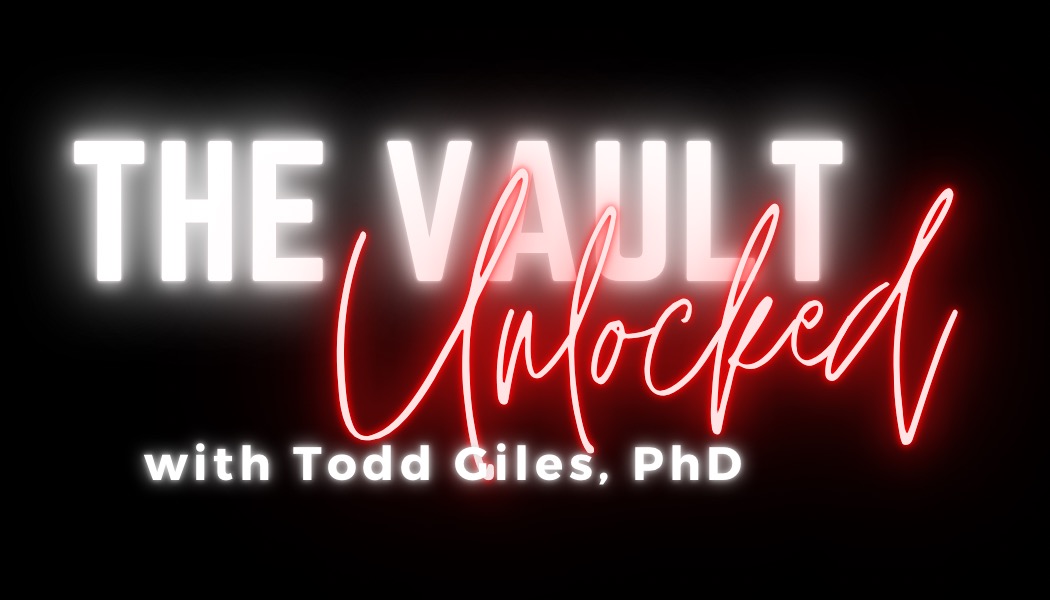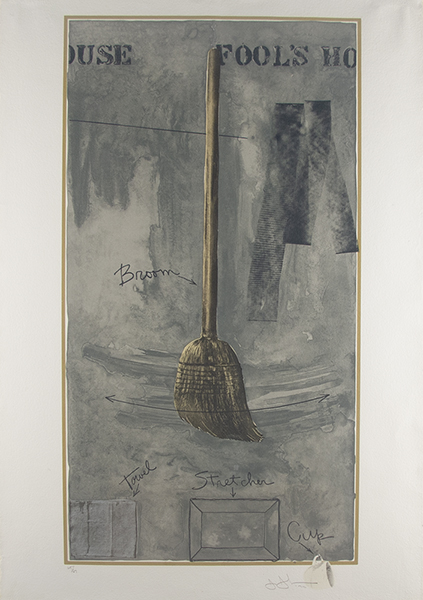
Ever wonder where the art is stored at the WFMA, and what's in there anyway? Join MSU professor Todd Giles as he unlocks the vault!

Jasper Johns
Fool’s House, 1972
Lithograph on special Arjomari paper
44" x 29”
Signed & dated in pencil, lower right
No. 65/67
Gemini G.E.L., Los Angeles
Museum purchase assisted by the National Endowment for the Arts, 1975
“Take an object. Do something to it. Do something else to it. [Repeat.]”
~ Jasper Johns
[Transcript]
Hello and welcome to The Vault Unlocked. My name is Todd Giles and we’re here to take you inside the collection vault at the Wichita Falls Museum of Art at MSU Texas, because getting to know art helps us better know ourselves. In this episode, we will take a close look at Jasper Johns’ 1972 lithograph titled Fool’s House.
The fact that the largest Jasper Johns retrospective to date wrapped up in February 2022 makes this an apropos time to pull Fool’s House from the vault for an exploration not only of the lithograph itself, but also a brief discussion on printmaking and the aura of artworks. The exhibition, titled “Jasper Johns: Mind/Mirror,” was comprised of over 500 artworks by Johns and was simultaneously hosted at two venues—the Philadelphia Museum of Art and the Whitney Museum of American Art in New York. This major retrospective is a reminder to this art lover that here at the WFMA we too hold works by some of the most important American artists stretching all the way back to the early 1700s, and that the WFMA collection and visiting exhibitions are in dialogue with museums and artworks around the world.
At the heart of the permanent collection are artworks by many of the key figures of the post-World War II era, which found its genesis in the United States at Universal Limited Art Editions (ULAE), a lithography workshop operated in the garage of Tatyana and Maurice Grosman in Long Island, New York. ULAE opened its doors in 1957 to artists who would become some of the most influential in America over the next two decades. Works by many of these artists were purchased by the Wichita Falls Museum of Art at MSU Texas in the early to mid-1970s. In 1960, Mrs. Grosman invited a young Jasper Johns to produce his first prints at ULAE. The following year, Abstract Expressionists Helen Frankenthaler and Robert Motherwell made their first prints with Mrs. Grosman as well; others represented in the WFMA’s collection include Larry Rivers, Sam Francis and Robert Rauschenberg. Three other printmaking workshops were also key in the development and dissemination of mid-twentieth century American art: Stanley William Hayter’s Atelier 17 in New York, June Wayne’s Tamarind Lithography Workshop, and Gemini G.E.L., the latter two located in Los Angeles. It was at Gemini G.E.L. that Johns composed Fool’s House in 1972.
One could argue that Johns’ (and Rauschenberg’s) primary importance in the post-World War II art world is that their work broke through what by the 1950s had become the officially sanctioned mode of artistic expression—the gospel of Abstract Expressionism. All new artistic movements seem to stem from rupture points. Once the avant-garde becomes the accepted tradition, well, then it’s time for another creative and philosophical disruption. In military parlance, the advance guard are the small bands of specialized soldiers who break through the line to see what lies ahead, so the next tactical plans can be laid for the troops’ movement forward at large. The avant-garde, whether in art or in warfare, always moves forward.
Johns’ and Rauschenberg’s advance wasn’t an overnight clean break from abstraction into realistic representation; rather, they brought the figure back into painting while still employing the gestural style of their predecessors like Jackson Pollock and Philip Guston. They did so, while also entering into dialogue with the found objects, play and intellectualism of Dadaist artist Marcel Duchamp of the preceding Modernist generation. Indeed, Johns and Rauschenberg are aptly referred to as Neo-Dadaists, for their style exists in that transitionary space between Abstract Expressionism and Pop Art.
Johns is best-known for his iconic paintings of American flags, targets, numerals, and Ballantine Ale cans, to name a few. All these images were revisited several times in various media throughout his career. (As of 2022, Johns is 92 years old!) According to John Dorfman in a recent issue of Arts & Antiques magazine, Johns had a “long-term preoccupation with duplication and repetition, as manifested in his penchant for redoing the same images with variations of color and context, as well as his enthusiasm for printmaking, a medium of multiples” (54). An example of this redoing can be seen in Johns’ lithograph Fool’s House, which is based on a 1962 oil painting on canvas of the same name with the inclusion of several objects. The original work is indeed a painting, but perhaps “assemblage” or “combine,” as Rauschenberg referred to some of his own works, is a better way to describe it, for it includes a real broom hanging from a hook, a dish towel, a small canvas stretcher, and teacup hanging from the lower right corner of the canvas from another hook.
“[D]uplication,” “repetition,” and “redoing”: three concepts equally at home in the Dadaism of Marcel Duchamp and the later Pop Art of Andy Warhol. Or, as Johns says in the epigraph above, “Take an object. Do something to it. Do something else to it. [Repeat.].” Artists, poets, composers (and, yes, even wily academics) sometimes poach from their earlier works, repeating images or themes in a variety of different media. Baroque composer Johann Sebastian Bach is a great example of this, as is American poet Walt Whitman, who revised and expanded nine volumes of his life’s work, Leaves of Grass.
The act of recycling brings up an interesting question when it comes to prints like Fool’s House: is the reusing of one’s earlier works by an artist a reproduction, or is it an entirely new can of worms? The question not only holds for Fool’s House, but also for at least two other artworks from this period in the WFAM’s permanent collection: Lee Krasner’s 1974 screenprint Embrace, which is based on her 1939 oil painting titled Olympic, and Jackson Pollock’s Untitled screenprint after his painting titled No. 9 from 1951. The question, then, is are these prints copies of originals or are they original works of art in their own right? Are they reproductions or are they somehow plays on or transcriptions of earlier works? Or perhaps re-representations? Who is to say how many times an artist can reuse their own images, poets their own poems, or cinematographers their favorite camera angles or filmic tropes?
According to Walter Benjamin’s seminal 1936 essay on film and photography titled “Art in the Age of Mechanical Reproduction,” paintings have always been reproducible in that they can be copied by hand by other artists. In the age of mechanical reproduction, however, the artwork’s aura is removed; that is, its “presence in time and space, its unique existence as the place where it happens to be” no longer exists because, through reproduction, it can be everywhere at once (220). We see, for example, Monet’s Water Lilies all over the place—on tee shirts, postcards, computer wallpapers, dorm room posters, in books, magazines, online, etc. But are we really seeing Water Lilies, or are copies of copies of Water Lilies something other than Water Lilies? For Benjamin, the aura was about authenticity and originality. Presence is the prerequisite; that is, being in the physical presence of an original.
What happens when presence becomes simultaneously multiplied through reproduction? Benjamin tells us that the “unique value of the ‘authentic’ work of art has its basis in ritual, the location of its original use value” (224). If the aura is where we locate the customary historical role of art, then the increasing intervention of technology in the production and reception of artworks tends to dissolve their importance according to this line of thought. That is, they lose their authenticity through the copies upon copies produced through the mechanical means of mass reproduction.
Where, then, do Benjamin’s ideas about originality and reproduction situate the art form of printmaking? Are prints originals or copies? Do the Krasner, Pollock and Johns prints mentioned here possess the same aura and authenticity of the original oil paintings they riffed on? Do they have the same level of cultural capital? Is one print “worth” more than another in the same run depending on when it was pulled? That is, is number one of sixty-seven of more value than number sixty-five? What about the artist proofs that precede the actual numbered edition? The fact that Fool’s House was produced in two different versions (one gray, one black) further complicates the matter. Or does it? Do these questions even matter, or should we borrow Johns’ broom and sweep them under the rug and say “any fool can see that Fool’s House is simply a picture of some of the day-to-day accoutrements of the artist’s home—broom, cup, towel, canvas stretcher and all.”
Although I tend to prefer questions to answers, let me see if I can tie up some of these loose ends. Every artwork in the WFMA’s collection of works on paper, whether produced in a run of sixty-seven prints or just one, is indeed an original artwork because printmaking is an artistic medium in its own right. Regardless of whether we’re talking about etching, lithography, screenprinting, woodcut or any of the other myriad techniques available to artists working in the medium, the art form uses printmaking techniques to create images, as opposed to a form of photo-mechanical reproduction. Part of this technique, for example, involves re-inking the lithographic stone or etching plate by hand for each print produced. In the case of Fool’s House, Johns worked with master printmakers Kenneth Tyler and Serge Lozingot, plus two others in the Gemini studio. In keeping, the compositional process is one of the things that makes printmaking so fascinating, especially when we consider that Fool’s House was composed with ten colors and produced not just on a single lithographic stone but also with an aluminum etching plate as well.
Now back to my original question: is the reusing of one’s earlier works by an artist a reproduction, or is it an entirely new can of worms? Is Johns’ 1962 painting Fool’s House the aura-wielding original and the sixty-seven lithographs mere copies thereof? No, they are all unique works of art with their own aura of originality. As art historian Ruth Fine points out, “[i]n working the print [of Fool’s House] a photo plate of the painting was used for the main imagery, but the markings, drawing, distribution of color, tensions, and general feel of the lithograph are quite distinct from those in the painting. A different set of circumstances is established because the objects are depicted instead of being literal” (67).
Thanks for joining us as we unlock the vault at the Wichita Falls Museum of Art at MSU Texas. To learn more about the WFMA, our current and upcoming exhibitions, the permanent collection, as well as sign up for our e-newsletter, visit wfma.msutexas.edu.
Works Consulted
Benjamin, Walter. “Art in the Age of Mechanical Reproduction.” Illuminations. Schoken Books, 1985, pp. 217-251.
Dorfman, John. “Double Vision.” Arts & Antiques XLIV.9 (Oct. 2021), pp. 52-59.
Fine, Ruth E. Gemini G.E.L.: Art and Collaboration. Washington: National Gallery of Art, 1985.
Fool's House from the Permanent Collection of the Wichita Falls Museum of Art at MSU Texas
View Previous The Vault Unlocked
-
Tuesday - Friday
10:00AM - 5:00PMSaturday
1:00PM - 5:00PM